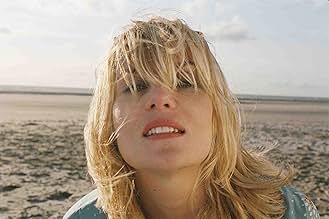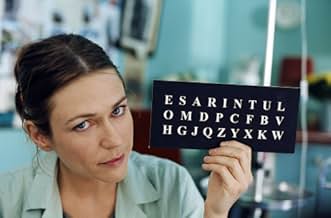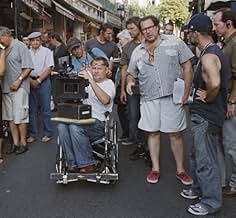L'histoire vraie de Jean-Dominique Bauby, rédacteur en chef du magazine Elle, victime d'un accident vasculaire cérébral et forcé de vivre avec un corps presque totalement paralysé ; seul son... Tout lireL'histoire vraie de Jean-Dominique Bauby, rédacteur en chef du magazine Elle, victime d'un accident vasculaire cérébral et forcé de vivre avec un corps presque totalement paralysé ; seul son oeil gauche est resté en activité.L'histoire vraie de Jean-Dominique Bauby, rédacteur en chef du magazine Elle, victime d'un accident vasculaire cérébral et forcé de vivre avec un corps presque totalement paralysé ; seul son oeil gauche est resté en activité.
- Réalisation
- Scénario
- Casting principal
- Nommé pour 4 Oscars
- 68 victoires et 107 nominations au total
Avis à la une
Beautifully shot by cinematographer Janusz Kaminski with a screenplay by Ronald Harwood, the film begins with Bauby's confused awakening in the hospital after twenty days in a coma. We see only a blur of images and claustrophobic close-ups that mirror the patient's mental state. We can make out a hospital room and doctors and nurses offering reassuring thoughts. We hear Bauby's words but the doctors do not and we know that while his body isn't functioning, his mind is as sharp as ever. With the help of a speech therapist (Marie-Josée Croze), and a very patient transcriber, a code is developed that allows Bauby (Mathieu Amalric), called Jean-Do by his friends and family, to compose a book based on his experience.
When the therapist recites the most-frequently used letters in the French alphabet, Bauby blinks when he wants to choose a letter. The book, on which the film is based, was published in 1997, shortly after Bauby's death. One of the most dramatic moments in the film occurs near the beginning when the first thought Jean-Do communicates is that he wants to die. Feeling rejected and angry, the therapist stomps out of the room but apologizes and comes back shortly to resume the treatment. We do not actually see Jean-Do until about a third of the way through the film but we can hear his thoughts which are in turn angry, funny, and bitterly ironic. Bauby compares his body to a deep-sea diver being suffocated in a diving suit and his poetic imagination to a butterfly.
It is Jean-Do's sense of humor that keeps the film as light as it can be under the circumstances and his eloquence that keeps us riveted. When we finally do see him with his immobile body and his drooping lower lip, it is still a shock but we smile when he says that "I look like I came out of a vat of formaldehyde." Much of the film vividly explores the editor's imagination and the camera takes us on some wild rides that include images of Nijinsky, Empress Eugénie, Marlon Brando, and Jean-Do in his imagination skiing and surfing. Some of the most emotional moments occur when he greets his young children at the beach for the first time after his stroke, a telephone "conversation" with his 92-year old father (Max Von Sydow), and flashbacks to his youth - driving with his girlfriend, shaving his father, supervising a fashion shoot, and taking his son on a trip in a new sports car. Bauby's wife Céline (Emmanuelle Seigner), whom he left for exotic girlfriend Ines (Agathe de La Fontaine), visits him in the hospital and comforts him while Ines cannot bring herself to see him, saying that she wants to remember him the way he was.
Realizing how his life had been less than exemplary, his stroke becomes an opportunity for redemption and allows him, if not to cleanse his soul, to discover that humanity lies in his consciousness not in material things or sexuality. The Diving Bell and the Butterfly is a film of enormous power that shakes us and enables us to get in touch with the miracle of each moment. Schnabel says that his purpose in making the film was to tell "the story of all of us, who surely do face death and sickness. But if we look", he says, "we can find meaning and beauty here." There is enough of both meaning and beauty to make The Diving Bell and the Butterfly one of the best films of the year.
This is an anti-Hollywood, anti-formula movie. Those have their place, but this is a great antidote to the silly decisions made by inappropriately powerful studio execs.
See it. You'll be thankful you did.
American born director Julian Schnabel picked up the memoir and made it into a movie that will re-examine the way a person will view his life. From the way the movie was presented to the audience, it might seems to be difficult to digest, but if you watch them once again, you will find that the flow of the movie follows closely to what is written on the book.
The story begins with Jean Dominique (Mathieu Amalric) finding himself woke up in a hospital,unable to move his body. Upon hearing from the doctor that a stroke left him unable to move, except his left eye, he found himself trapped in a prison: his body. He describes his body as a diving bell, where death sentence prisoner would wore the diving bell and drowned in the sea. With doctors and therapists taking care of him, he found himself living without dignity.
With the help of Henriteet (Marie Jozee Croze), a speech therapist, she uses a unique method of communicating with Jean thru pronouncing the alphabets and Jean would form a word or sentence by blinking the eye. After getting to know her much more better, Jean found his way to survive thru the disabilities: imagination and beautiful memories. Both set his spirit free, and he feels like he is flying like a butterfly. And thus he began writing his memoirs of his life.
The story is told through the view from Jean's left eye and reaction in his mind after the stroke. This pulls the audience and the inner world of Jean closer, and audience could have a feel of putting themselves into Jean's shoes. From the effort the cast and crew puts in the movie, we can tell that the movie is follow everything accordingly to the book, without any adjustments.
The Diving Bell and the Butterfly is the movie that you need if you want to take a break from normal popcorn flicks, or a movie that makes you think through about yourself, and how you live life to the fullest.
There is a seamless blend of cinematography with the music to enhance the inner life of the main character, the viewer is at one with his inner frustration, his soaring imagination, his follies, faults and lusts. At times it is humorous, at others there are indelible vignettes - one of the long term partner (beautfully played by EmmanuelleSeigner) assisting his lover to communicate with him by telephone. Another is the incredible Max Von Sydow in a riveting performance as the elderly heart-broken father.
The film is based on a true story and it must have been an enormous challenge to bring this story to the screen. Julian Schnabel directed the amazing cast and brought an artistry to the project that is extremely rare in film making. To capture the world as seen through the eye of a paralyzed man and make it so fascinating took enormous skill.
I was captivated and enchanted and would definitely see it again. 9 out of 10. Not to be missed.
The film deals with a rare physical condition, and I was physically there with the character from start to finish. I felt each moment as if it were my own. That is a rare accomplishment in cinema. Julian Schnabel directed a stellar cast. Mathieu Amalric was unusually charming as Jean-Dominique Bauby, and Max Von Sydow was heartbreaking as his lonely widower father. The female leads were all equally impressive as they were beautiful. I don not mean to generalize them, but they were all so excellent that they blend seamlessly in my mind, in terms of performance.
Overall, this film was as pure a cinematic experience as I've witnessed in a long time. A true artist turns out a film that is truly a piece of art. Julian Schnabel takes his time in between films, but with work like this, there's no need to rush. Like a good painting, one can enjoy it for a lifetime.
Le saviez-vous
- AnecdotesTo familiarize himself with Bauby's sheltered existence, director Julian Schnabel made the movie in the same hospital where Bauby was treated, meeting many of the orderlies who had treated him. He also shot scenes on the same balcony where Bauby relaxed, and on the same nearby beach to which his family had taken him.
- GaffesWhen Jean-Dominique goes on a boat ride, a 'Speedferries' vessel can be seen in the background. Speedferries started business in 2004, years after the movie was set.
- Citations
Jean-Dominique Bauby: I decided to stop pitying myself. Other than my eye, two things aren't paralyzed, my imagination and my memory.
- Bandes originalesTheme for The Diving-Bell and the Butterfly
Composed by Paul Cantelon
Studio recording The University of Victoria
Engineer / Producer Russell Dawkin
Meilleurs choix
Détails
- Date de sortie
- Pays d’origine
- Site officiel
- Langue
- Aussi connu sous le nom de
- El llanto de la mariposa
- Lieux de tournage
- Sociétés de production
- Voir plus de crédits d'entreprise sur IMDbPro
Box-office
- Montant brut aux États-Unis et au Canada
- 6 003 227 $US
- Week-end de sortie aux États-Unis et au Canada
- 75 721 $US
- 2 déc. 2007
- Montant brut mondial
- 19 780 116 $US
- Durée
- 1h 52min(112 min)
- Couleur
- Mixage
- Rapport de forme
- 1.85 : 1




























